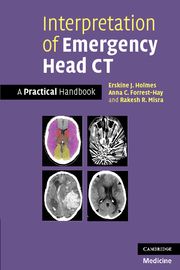Book contents
- Frontmatter
- Contents
- Acknowledgements
- Preface
- Abbreviations
- Introduction
- Section 1
- Section 2
- Reviewing a CT scan
- Acute stroke
- Subdural haematoma (SDH)
- Extradural haematoma
- Subarachnoid haemorrhage
- Cerebral venous sinus thrombosis
- Contusions
- Skull fractures
- Meningitis
- Raised intracranial pressure
- Hydrocephalus
- Abscesses
- Arteriovenous malformation
- Solitary lesions
- Multiple lesions
- Self-assessment section
- Self Assessment – Answers
- Appendices
Multiple lesions
from Section 2
Published online by Cambridge University Press: 05 November 2009
- Frontmatter
- Contents
- Acknowledgements
- Preface
- Abbreviations
- Introduction
- Section 1
- Section 2
- Reviewing a CT scan
- Acute stroke
- Subdural haematoma (SDH)
- Extradural haematoma
- Subarachnoid haemorrhage
- Cerebral venous sinus thrombosis
- Contusions
- Skull fractures
- Meningitis
- Raised intracranial pressure
- Hydrocephalus
- Abscesses
- Arteriovenous malformation
- Solitary lesions
- Multiple lesions
- Self-assessment section
- Self Assessment – Answers
- Appendices
Summary
Characteristics
Neoplastic causes: Brain metastases are the most common neoplastic intracerebral lesion. They are found in up to 24% of all patients that die from cancer, and represent 20–30% of all brain tumours in adults.
Infective causes: For example, cerebral abscesses, granulomata.
Vascular causes: Multiple lesions of varying age are seen in multi-infarct dementia.
Inflammatory causes: Demyelinating plaques can be seen as multiple low density lesions on CT, predominantly in the periventricular deep white matter.
Traumatic causes: Contusions are frequently multiple after head trauma.
Clinical features
Depends on the underlying pathology.
See solitary lesions.
Radiological features
Contrast is taken up in tumours, inflammatory granulation tissue or areas of damage to the blood–brain barrier. Melanoma and adenocarcinoma metastases may appear hyperdense prior to contrast.
Calcification in malignant tumours is uncommon but, if present, suggests an adenocarcinoma. Calcification following granulomatous infection in not uncommon.
Haemorrhage into metastases occurs infrequently, and when present suggests hypervascular tumours such as melanoma or hypernephroma.
A follow-up CT performed two weeks after a traumatic event makes multiple contusions more conspicuous.
- Type
- Chapter
- Information
- Interpretation of Emergency Head CTA Practical Handbook, pp. 89 - 91Publisher: Cambridge University PressPrint publication year: 2008



